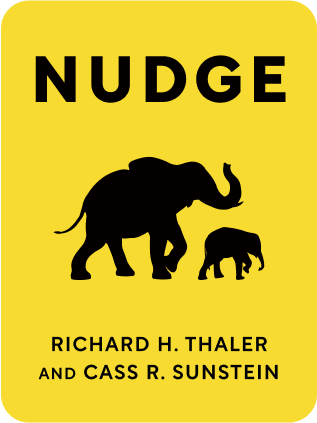

This article is an excerpt from the Shortform summary of "Nudge" by Richard H. Thaler and Cass R. Sunstein. Shortform has the world's best summaries of books you should be reading.
Like this article? Sign up for a free trial here .
What are health nudges? What is Nudge theory in health?
Health nudges are nudges to encourage better choices in health and healthcare. For example, you may be incentivizing wellness or pushing people towards health insurance coverage.
Read more about health nudges and choice architecture in healthcare.
Overview of Health Nudges
According to the National Health and Nutrition Examination Survey (2013–14), administered by the National Institutes of Health, more than two-thirds of US adults are either overweight or obese, and 1 in 13 adults is considered to be “extremely obese.” Tens of thousands of Americans are on organ waiting lists due to a chronic shortage of organ donors. And our environment is continually at risk—from climate change, pollution, and unsustainable agriculture. Suffice it to say, Americans could use some health nudges for their own wellbeing.
Case Study: Reimagining Medicare Part D
Like Sweden’s privatized social security program, Medicare Part D—the prescription-drug benefit for American seniors passed in 2003 and rolled out in late 2005—suffered from poor choice architecture that confounded its constituency. This case study explores choice architecture in healthcare.
Flaw 1: Too many choices, not enough help
When the first enrollment period began in November 2005, the program offered seniors a choice of, on average, between 40 and 50 prescription-drug insurance plans with little personalized guidance.
Flaw 2: Bad defaults, especially for the neediest
Because about half of US seniors already had prescription drug coverage through their insurance when Medicare Part D was implemented, the program was made voluntary for most of the senior population (i.e., the default was non-enrollment). For a particular subset of seniors known as “dual eligibles”—poor or disabled Americans who qualified for both Medicare and Medicaid—the default was enrollment in one of several very basic plans. The problem was that this plan was chosen at random. In other words, the most vulnerable segment of the senior population, whose medical needs were generally more complex and expensive than the average, was sifted into random plans that may or may not have covered individuals’ particular prescriptions. Health nudges could have prevented this.
Flaw 3: Poor user-experience design
The hub of engagement with Medicare Part D was the plan’s website, where users could compare plans based on their particular medical needs and eventually choose a plan. One issue with this decision was that, in 2005, scant few seniors knew how to use a computer, much less navigate a complex website. Add to that misapprehension a less-than-ideal user interface—one that, for example, didn’t spell-check drug names and featured constantly updating prices—and you greatly increase the chance of an enrollee choosing a plan that’s not right for them.
For example, one study showed that in an extremely simplified environment, wherein there were only four plans and all were the same price (but offered different benefits), nearly two-thirds of seniors chose a plan that didn’t minimize their out-of-pocket costs. This suggests that the actual Medicare Part D choice system, which featured approximately 45 choices with an array of variables from cost to coverage, would be incomprehensible to your average senior.
Recommendations
Obviously, Medicare Part D would have been greatly improved had its choice architecture been designed according to libertarian paternalistic principles. Thaler and Sunstein offer two recommendations based on choice architecture in healthcare:
Recommendation 1: Intelligent Defaults
Rather than assign “dual eligibles” to random plans if they fail to choose a plan actively, the (choice) architects of Medicare Part D should have developed a system of “intelligent assignment,” whereby past medical information and other data were used to funnel dual eligibles in particular plans.
Maine, in fact, did use health nudges with “intelligent assignment” to handle the state’s dual eligibles that neglected to choose a prescription plan. Assignments were based on individuals’ prescription data from the previous three months, and current enrollees were either transferred into plans that covered more than 80% of their medications or received a letter notifying them that a cost-effective plan was available to them. These measures resulted in every dual eligible receiving coverage for 90%–100% of their drugs from their plan.
Recommendation 2: RECAP
Under a RECAP regime of health nudges, Medicare Part D plans would provide enrollees with an annual report that includes an itemized list of medications used and fees incurred. This plan would be available digitally as well as physically, thus allowing for it to be imported into the Medicare website or third-party applications for comparison with competing plans’ coverage. This information could also be used by the government itself to nudge people toward better plans: A study of Wisconsin beneficiaries showed that when enrollees were mailed a letter specifying a more tailored and cost-effective plan was available to them, 27% transferred to the recommended plan (whereas only 17% switched when sent generic Medicare Plan D literature).

———End of Preview———
Like what you just read? Read the rest of the world's best summary of Richard H. Thaler and Cass R. Sunstein's "Nudge" at Shortform .
Here's what you'll find in our full Nudge summary :
- Why subtle changes, like switching the order of two choices, can dramatically change your response
- How to increase the organ donation rate by over 50% through one simple change
- The best way for society to balance individual freedom with social welfare






